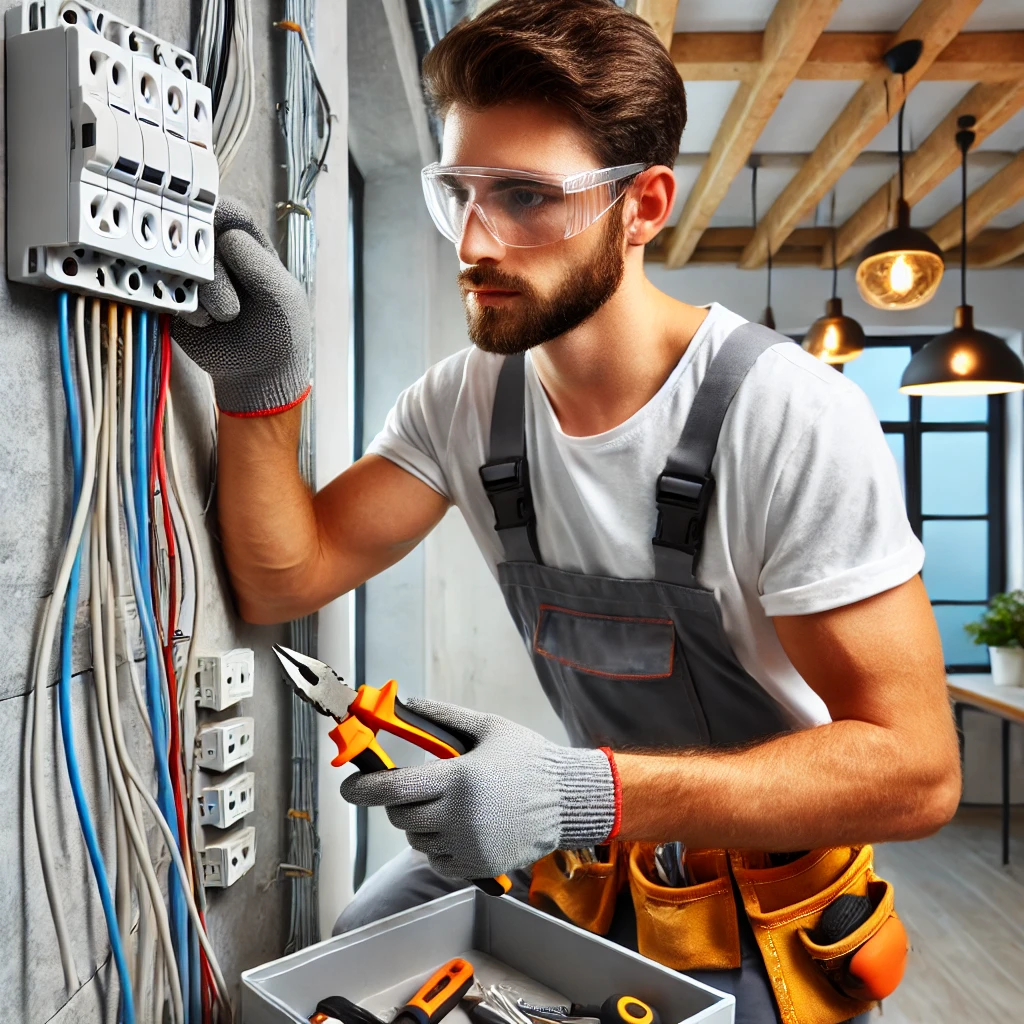Electrical installation is a critical aspect of building construction and maintenance. Ensuring that electrical systems are installed correctly is paramount for both safety and functionality. Whether you are a homeowner looking to upgrade your electrical system or a business owner setting up new premises, understanding the intricacies of electrical installation is essential.
Understanding Electrical Installation
Electrical installation involves the setup of electrical systems that provide power to buildings, machinery, and other infrastructures. This process includes the installation of wiring, outlets, switches, panels, and other electrical components that ensure the safe and efficient operation of electrical devices.
Importance of Proper Electrical Installation
Proper electrical installation is crucial for several reasons. It ensures the safety of the inhabitants, prevents electrical fires, and guarantees the efficient functioning of electrical appliances. Faulty installations can lead to short circuits, electrical shocks, and even fatal accidents. Therefore, adhering to electrical codes and standards during installation is vital.
Electrical Installation Safety Tips
Safety is paramount in electrical installation. Here are some essential safety tips to keep in mind:
Safety Precautions Before Starting
Before beginning any electrical installation, it is crucial to take safety precautions. Always turn off the main power supply to avoid electrical shocks. Use insulated tools and wear protective gear such as gloves and safety goggles. Ensure the work area is dry and free from any conductive materials.
Using Proper Tools and Equipment
Using the right tools and equipment is essential for a successful electrical installation. Invest in high-quality insulated tools designed for electrical work. Ensure you have the necessary equipment, such as voltage testers, wire strippers, and pliers, to perform the job safely and efficiently.
Identifying Potential Hazards
Identifying potential hazards is a key step in ensuring safety during electrical installation. Look for signs of wear and tear on existing wiring, check for loose connections, and be cautious of any exposed wires. Addressing these hazards before starting the installation can prevent accidents and ensure a smoother process.
Steps in the Electrical Installation Process
A systematic approach to electrical installation can ensure a successful outcome. Here are the main steps involved:
Planning and Designing the Electrical System
Planning and designing the electrical system is the first step in the installation process. This involves creating a detailed layout of the electrical components and their locations. Consider the power requirements of the building and design the system to accommodate current and future needs.
Obtaining Necessary Permits
Before starting the installation, it is important to obtain the necessary permits from local authorities. This ensures that the installation complies with local building codes and regulations. Working without permits can result in fines and legal issues.
Installing the Electrical Panel
The electrical panel, also known as the breaker box, is the central hub of the electrical system. Installing the panel involves mounting it securely and connecting it to the main power supply. Ensure that the panel is easily accessible for maintenance and emergencies.
Wiring and Circuit Installation
Wiring and circuit installation is a critical part of the process. Use high-quality wires and follow the layout plan to run the wires through walls, ceilings, and floors. Ensure proper connections and secure the wires with clips or conduits to prevent them from moving or getting damaged.
Installing Outlets and Switches
Installing outlets and switches involves connecting them to the wiring and securing them in place. Ensure that they are properly grounded and test them for functionality. Use outlet and switch covers to protect them from dust and moisture.
Testing the Electrical System
Once the installation is complete, it is essential to test the electrical system to ensure it is functioning correctly. Use a voltage tester to check the power supply to each outlet and switch. Verify that the circuit breakers are working properly and that there are no loose connections.
Types of Electrical Installations
Electrical installations vary based on the type of building and its power requirements. Here are the main types:
Residential Electrical Installations
Residential electrical installations are designed for homes and apartments. They typically include the installation of lighting, outlets, switches, and appliances. Ensuring the safety and efficiency of these installations is crucial for the comfort and security of the residents.
Commercial Electrical Installations
Commercial electrical installations are for businesses and office buildings. These installations often require more complex systems to support the higher power demands of commercial equipment. They must comply with stricter codes and standards to ensure the safety of employees and customers.
Industrial Electrical Installations
Industrial electrical installations are the most complex and require specialized knowledge and skills. These installations power machinery and equipment used in manufacturing and other industrial processes. They must be robust and reliable to ensure continuous operation and safety in industrial environments.
Common Electrical Installation Mistakes to Avoid
Avoiding common mistakes can ensure the success of your electrical installation. Here are some pitfalls to watch out for:
Overloading Circuits
Overloading circuits is a common mistake that can lead to electrical fires. Ensure that each circuit is designed to handle the power load of the connected devices. Use circuit breakers to protect against overloads and distribute the electrical load evenly across multiple circuits.
Improper Grounding
Improper grounding can result in electrical shocks and equipment damage. Ensure that all electrical components are properly grounded to provide a safe path for electrical currents. Use ground fault circuit interrupters (GFCIs) in areas where water is present, such as kitchens and bathrooms.
Incorrect Wire Sizes
Using incorrect wire sizes can cause overheating and electrical fires. Ensure that the wires used are suitable for the electrical load they will carry. Follow the recommendations in the National Electrical Code (NEC) for wire sizes and ampacity ratings.
Benefits of Professional Electrical Installation Services
Hiring a professional for your electrical installation offers several advantages:
Expertise and Knowledge
Professional electricians have the expertise and knowledge to perform installations safely and efficiently. They are trained to handle complex electrical systems and can identify potential issues before they become problems.
Compliance with Codes and Standards
Professional electricians ensure that the installation complies with local codes and standards. This is crucial for safety and legal compliance. They also stay updated with the latest regulations and technologies in the field.
Quality Assurance and Warranty
Professional installation services often come with quality assurance and warranties. This provides peace of mind knowing that the installation is done correctly and that any issues will be addressed promptly. It also adds value to the property.
DIY Electrical Installation: Pros and Cons
While some may consider DIY electrical installation, it comes with its own set of pros and cons:
Advantages of DIY Electrical Installation
DIY electrical installation can save money on labor costs and provide a sense of accomplishment. It allows homeowners to customize the installation to their preferences and schedule.
Risks Associated with DIY Electrical Installation
However, DIY electrical installation carries significant risks. Lack of experience and knowledge can lead to mistakes that compromise safety. Electrical work requires adherence to codes and standards, which DIYers may not be familiar with. Additionally, improper installation can void insurance coverage and warranties.
Choosing the Right Electrical Installation Service
Selecting the right electrical installation service is crucial for a successful project:
Factors to Consider When Hiring an Electrician
When hiring an electrician, consider their experience, reputation, and pricing. Look for electricians who specialize in the type of installation you need and have a track record of successful projects.
Importance of Licensing and Certification
Ensure that the electrician is licensed and certified. Licensing indicates that the electrician has met the necessary training and experience requirements. Certification from reputable organizations further demonstrates their expertise.
Customer Reviews and Recommendations
Check customer reviews and ask for recommendations from friends and family. Positive reviews and word-of-mouth recommendations are good indicators of a reliable and trustworthy electrician.
Future Trends in Electrical Installation
The field of electrical installation is constantly evolving. Here are some future trends to watch for:
Smart Home Integrations
Smart home technologies are becoming increasingly popular. Integrating smart devices into electrical systems allows for greater control and efficiency. Electricians need to stay updated with these technologies to meet customer demands.
Energy-Efficient Electrical Installations
Energy efficiency is a growing concern. Electricians are focusing on installing energy-efficient systems that reduce power consumption and lower utility bills. This includes the use of LED lighting, energy-efficient appliances, and solar power systems.
Innovations in Electrical Installation Technology
Technological advancements are shaping the future of electrical installation. Innovations such as wireless charging, smart grids, and advanced automation are becoming more prevalent. Electricians must adapt to these changes to provide cutting-edge services.
FAQs
What is the most important step in electrical installation?
The most important step in electrical installation is planning and designing the electrical system. A well-designed plan ensures that all components are properly installed and that the system can handle the required power load.
How do I ensure my electrical installation is safe?
To ensure your electrical installation is safe, hire a licensed and certified electrician, follow local codes and standards, use high-quality materials, and regularly inspect and maintain the system.
Can I do electrical installation myself?
While it is possible to do electrical installation yourself, it is not recommended unless you have the necessary knowledge and experience. DIY electrical work can be dangerous and may not comply with local codes.
What are the common signs of electrical installation problems?
Common signs of electrical installation problems include flickering lights, tripped circuit breakers, burning smells, and warm outlets or switches. If you notice any of these signs, contact a professional electrician immediately.
How often should electrical installations be inspected?
Electrical installations should be inspected at least once every three to five years. Regular inspections ensure that the system is safe and functioning correctly and can identify potential issues before they become serious problems.
What should I look for in a professional electrical installation service?
When choosing a professional electrical installation service, look for licensing and certification, experience, customer reviews, and pricing. Ensure the electrician specializes in the type of installation you need and has a good reputation for quality work.
Conclusion
Electrical installation is a complex and essential process that requires expertise and attention to detail. Proper installation ensures the safety and efficiency of electrical systems, whether for residential, commercial, or industrial purposes. By following safety tips, avoiding common mistakes, and choosing professional services, you can achieve a successful electrical installation that meets your needs and complies with all necessary standards.







